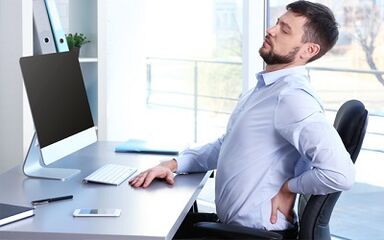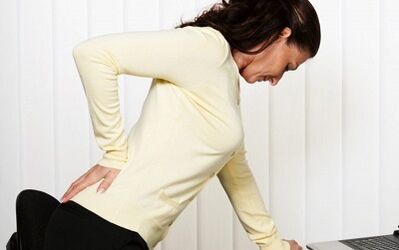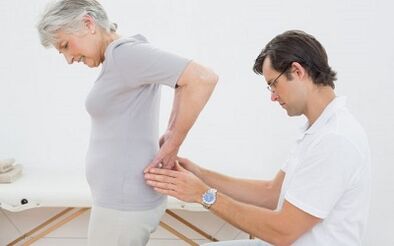
Acute pain in the lower back against the bottom of spine osteochondrosis is a widespread problem that the vast majority of people face.Arriving at us "as a reward" by our direct (due to increased axial load in the spine spine), this disease earlier or later affects each resident of the planet, the only question is the speed with which this is expressed.Such "thin" statistics force this pathology to socially significant diseases, and the struggle against it must be the task not only of a person who suffers from manifestations of the disease, but also from the world health system as a whole.Therefore, the question of the treatment of spine osteochondrosis is a very relevant topic.
So what is osteochondrosis?Consider briefly how the disease development occurs.In its own name, if you literally translate it from Latin, the structures that change with osteochondrosis are determined: bone and cartilage.In order to depreciate and resist vertical loads, the nature placed among our vertebrae is a peculiar "pillows" chryshot pillows.Its nutrition is performed in childhood due to blood vessels, lost for approximately 25 years, and nutrition begins to be diffusely due to surrounding muscles.
In pathological charges in the spinal column (sedentary work or vice -versa - excessive physical activity), violations of mineral metabolism processes, the intervertebral disc loses its elastic and amortizing properties, its height decreases, the structure of the vertebers, the changes of pathological bonuses (ostors. The affected area of the spine.Jacket nucleus so that, breaking the fibrous ring, forms a kind of protrusion bag between the body of the vertebrae - the intervertebral hernia. A hernia can cause compression of the nerve roots adjacent to the vertebrae, the intense pain occurs in the area regulated by the affected nerve.Skeletal muscles, called protective defense in medicine, which, on the one hand, protects the suffering section of the spine from excessive movements and, on the other hand, increases compression, edema and pain in the affected area.
In the vast majority of cases (90%), pain with osteochondrosis (even extremely pronounced) is due to muscle spasm!In other cases, the cause of pain is compression of the nerve root or spinal cord directly through the intervertebral disc hernia.
Lumbar spine osteochondrosis: how to treat
Of all parts of the spine and, in total, there are five (cervical, chest, lumbar, sacral and coccigeal), due to higher motor load, the lumbar most often suffers from the manifestations of the disease.Lumbar spine osteochondrosis has brilliant symptoms for everyone, and its treatment is a significant social task as it worsens the quality of life not only of the elderly, but also active active people.
The pain can be located directly in the lower back, as well as on the frontal surface of the thigh, or along the back or external surface of the leg, sometimes to the fingers.Often the pain is given to the glute, sacred, groin region and sometimes they can only be located in these areas, disguised as diseases of the genitourinary sphere and intestines and hindering the production of correct diagnosis.The intensity of pain syndrome can be so high that a person loses the ability to make the most elementary movements, takes forced poses and loses normal sleep.This is the same radicolit, which in large circles has become a synonym for the disease itself.

Limiting motor activity.Usual movements and limb sensitivity are violated, muscle seizures, paresthesia (tingling sensations, burning “goose bumps”).
Violation of the function of the pelvic organs.With intense root syndrome, known to all as radicoito, or with massive hernial protrusion, urination and intestinal work may even be disturbed, causing a severe torment to the patient.
Treatment of lumbar spine osteochondrosis usually becomes a difficult task for the patient and the doctor.Each person who suffers from this disease was asked by questions: “How to treat lumbar osteochondrosis?”, “How to treat lumbar region osteochondrosis?”, “If the treatment of lumbar department osteochondrosis at home does not help - which doctor
The following doctors will help deal with osteochondrosis exacerbation and prescribe competent treatment: therapist, neurologist, medical massage specialist, manual therapist, physiotherapist and, if necessary, surgical treatment is a neurosurgery.
Ways to combat lumbar spine osteochondrosis
The main thing in the treatment of osteochondrosis is the right lifestyle!In people who are actively and correctly involved in physical culture and monitor the spine, the back never hurts!Unfortunately, few people follow these simple truths.
When analyzing this problem, you can highlight:
- medicine;
- No -Drug.
NO -Drug Methods for the Treatment of Lumbar Spine Pathology
- Distraction procedures.Its effect is in its own name - the use of various applicators, rugs and rollers, wool belts, “lotions” and “scrub” due to the effects on surface nerve endings and blood vessels slightly reduces muscle spasm and pain syndrome.These methods can be used as an auxiliary, but isolated use to exacerbate osteochondrosis of the without systemic lumbar treatment with special medicines is ineffective.
- Immobilization means.These means are understood as bandages from various projects, whose use allows to protect the column from sudden and "dangerous" movements and redistribute the load during static work.Immobilization means can be purchased at medical equipment and pharmacies stores, however, before buying, it is advisable to consult a doctor who will help determine the ideal design, stiffness and dressing in the situation.It is advisable to use them only for the time of exposure to adverse factors (wheel trips, sitting work and so on), since prolonged use causes muscle hypotrophy.
- Medical Physical Education (Exercise Therapy)- An integral component of the complex treatment of osteochondrosis.Perform exercises designed to maintain the tone of the muscles of the back structure and remove pathological muscle spasm helps restore and maintain motor activity, reducing the intensity of pain syndrome.A significant advantage of exercise therapy is that, after training of the instructor, a person can perform exercises independently daily, as well as in the existence of a set of applicable exercises, even with an exacerbation of the process.The most effective method of exercise therapy is mechanotherapy - classes on simulators according to an individually developed method, as the formation of muscle corset needs to work with weights.
- Massage- An acquaintance of ancient times, the most common and perhaps the most common way of preventing and treatment, however, cannot be used in the exacerbation phase of lumbar osteochondrosis.In addition, only a medical education expert who knows anatomy and physiology and medical massage property techniques, must perform massage with osteochondrosis.
- Manual therapyAnd in recent years, osteopathy in recent years performed by a competent professional may have a significant healing effect and even eliminate the exacerbations of the disease for a long time.It is also important to remember that when addressing a manual therapist before the beginning of the procedures, a column tool is required (radiography, calculated or magnetic resonance, osteodensitometry) to allow the doctor to evaluate the prevalence and severity of the process and exclude possible contrasts for manipulation.Like massage, manual therapy and osteopathy, they have several against -indications, for example, a pronounced compression of the nerve root of the hernias, subluxation of the vertebrae.In the acute period of lumbar osteochondrosis, manual therapy techniques (muscle relaxation and so on) are usually used.
- Acupuncture.Based on the results of recent studies, the use of this method of popular methodology in large circles is considered evidence -based, irrational irrational for lumbar spine osteochondrosis that does not eliminate disease symptoms and refers to non -traditional treatment methods.
- Physiotherapy, included in clinical recommendations and national standards for medical care for osteochondrosis, have long proved their effectiveness in treating this disease.With lumbar spine osteochondrosis, electromystimulation, amplipulse therapy, shock wave therapy, intrachemic miostimation and laser therapy.Magnetotherapy remains the popular method in complex treatment.Its advantages include good tolerance and a small list of contrasts, the possibility of use in the acute period of the disease.Acting in all links in the pathological process, after several procedures, significantly reduces pain and allows a person to expand motor activity.In addition, by improving the tropism of affected tissues, it decreases the progression of the disease.An unconditional advantage of this method is the possibility of its independent use by the patient outside the walls of a medical institution.
But if all the no -Drug methods above were ineffective - how to treat lumbar osteochondrosis?
Drug treatment
Diseases involve the appointment of the following medicinal groups.
Non -esteroid anti -inflammatory drugs (NSAIDs) are produced in places for locations (gels, ointments, cream) and systemic use (tablets, candles, intramuscular and intravenous administration solutions).Its action is based on blocking the inflammatory process at the enzyme level as a result of which edema in the lesion zone is eliminated and pain syndrome is significantly reduced.
In the early stages of the disease, there is enough local use of NSAIDs in combination with non -valley methods (therapeutic exercises, magnetotherapy).With a pronounced pathological process and intense pain syndrome, you need to resort to tablets and sometimes injecting forms of medications.
Unfortunately, having a good anti-inflammatory and analgesic effect of NSAIDs, with prolonged systemic use, the development and exacerbation of the ulcerative-intro-zeal processes of the gastrointestinal tract, as well as impair renal and liver function.Therefore, patients who take NSAIDs for a long time need medications that protect the gastric mucosa and regular laboratory control of the liver and kidneys.
Systemic muscle relaxors, that is, medicines that relieve muscle spasm.The principle of its action is in the title: the relaxation of the spasmodic muscles helps to reduce nerve compression and blood vessels, edema in the damage zone - blood circulation and innervation improves - pain decreases;Due to decreased muscle defense, the ligament apparatus tension decreases - the stab (protrusion) of the intervertebral disc decreases - the pain decreases, the volume of movements increases.
Rusorelaxants for the treatment of spine osteochondrosis are produced in the form of tablets and intramuscular administration solutions to achieve the therapeutic effect, they should be taken for a long time, gradually increasing the dose.Like NSAIDs, muscle relaxants have several against -indications and can cause undesirable side effects, so despite the free sale in pharmacies, before buying them, you need to consult a doctor.

Local anesthetics or medicines for local anesthesia are used for drug treatment of lumbar osteochondrosis in the form of paravertebral lock called, when the drug solution is first administered subcutaneous and then in the area of vertebral processes affected in the projection of alleged root root compression.
When accumulating in nerve fiber membranes, the drug effectively blocks the sign of pain.The therapist will certainly not be able to perform this block;Due to your conduct, you need to contact a neurologist or neurosurgeon.
In addition, glucocosteroid solutions (GKS) - Hormonal drugs with a pronounced anti -inflammatory effect are sometimes used for paravertebral administration.Their local application allows for maximum effect by minimizing the risk of undesirable side effects of the drug.This block is conducted 2-3 times a year, a neurologist or neurosurgeon doctor should perform them.
Vitamins B "B".In any pharmacy, you can find a variety of medicines in this group, both in oral administration and intramuscular administration.They are believed to have a neurotrophic and lightweight analgization effect, however, a reliable justification for their use for spine osteochondrosis was not obtained by evidence -based medications.
Physiotherapy for Lumbar Osteochondrosis
Unfortunately, sometimes comprehensive treatment using modern medications, physiotherapy, massage and exercise therapy is ineffective - a person continues to feel pain, restriction of physical activity remains and quality of life suffers significantly.This happens in the posterior stages of the disease, when volumetric hernias are formed, often multiple of intervertebral discs.In such a situation, surgical treatment is shown.In addition, surgery is indicated by the "deterioration of a hernia", when significant compression of the spinal canal causes mismatch, statodynamic disorders and blading bladder and intestine function.In such cases, the operation is carried out in an emergency order.The purpose of surgical interventions for lumbar spine osteochondrosis is mechanical decompression of the spinal canal and nerve roots.
Currently, the two longtime volumetric surgical methods are used in the surgical treatment of osteochondrosis and minimally invasive endoscopic interventions proposed by modern medicine using laser and radio frequency effects, some of which can be performed even under local pain relief.
Having examined the main methods of treatment of lumbar spine osteochondrosis, I would like to observe once again that the patient asked the question "How to cure lumbar osteochondrosis?"It should trust not only the help of doctors, but also in their own strength, to understand the meaning of a healthy lifestyle, in which the proper dose and mainly dose physical activity is well -being and, most importantly, a branch of IN is present.Victory over the disease.














































